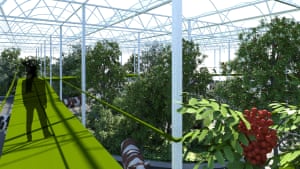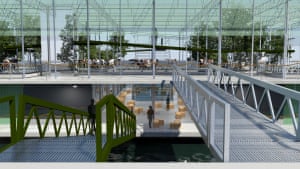 Do cows get seasick? It’s not a question farmers often ask, except in the Dutch city of Rotterdam where a team of developers plans to build a floating dairy.
Do cows get seasick? It’s not a question farmers often ask, except in the Dutch city of Rotterdam where a team of developers plans to build a floating dairy.
“They won’t here,” says Minke van Wingerden of Beladon, a company involved with water-based projects from a luxury hotel to this floating farm proposed for Rotterdam harbour. “In Friesland, where I come from, sometimes they bring cows from one place to another on a small barge,” van Wingerden recalls. “[The floating farm] will be very stable. When you are on a cruise ship, you aren’t seasick.”
Beladon’s €2.5m project (£2m) envisages 40 cows on a 1,200 square metre floating platform, producing 1,000 litres of milk a day to be pasteurised and processed into yogurt in a dairy on the floor below.
The building is planned in concrete, relatively light and buoyant, with galvanised steel frames and a special membrane floor that lets bovine urine soak through. A machine will mop up dry cow dung as another robot tops up food stations. The cows will wander in and out of stalls and the milking section, and can also potter over a ramp to real-life pasture on the land.
On the ground floor, as well as the processing of milk, water from the cows’ urine will be purified and used to grow red clover, alfalfa and grass under artificial light for fodder. Cow’s manure will either be used or dispatched to a nearby farm.

The project developers, who hope to begin building this autumn, say this kind of “closed-loop system” will be a paradigm for feeding cities in an ever more populous and urbanised world.
“The world’s population is rising, and most cities in deltas are sinking because of more and more concrete,” says van Wingerden. “My husband Peter [chief executive of Beladon] visited New York, there was Hurricane Sandy and he saw the shelves were empty; there was only food for two days. He thought we had to do things in another way, and the idea came: why not build a floating farm?”
For an entrepreneur involved in building a floating cruise terminal, nightclub and five star hotel, this wasn’t such a strange idea. He found fellow thinkers in the Dutch city farm Uit Je Eigen Stad (from your own town), which aims to reconnect city dwellers with their food, dairy innovation group Courage, and the Rotterdam harbour’s SOFIE fund. These groups are putting up the cash and trying to hammer out planning permission with Rotterdam council.
Johan Bosman, cofounder of the Uit Je Eigen Stad farm, restaurant and market in Rotterdam, said: “The world will grow, and more and more people will live in delta cities. Expanding cities need unbuilt areas and green space for housing purposes, so there’s less space for traditional food production. The logical consequence is that we will look to the water to produce some of the fresh food.
“In the Netherlands, fresh food is available and we don’t have very large cities, but we have a lot of agricultural and maritime expertise. We are combining these sectors to try to make an innovative circular farm to produce fresh dairy products, and by doing so make the city more resilient.”
He admits it’s a challenge: “Cows are pretty hard. They are large animals, and there are a lot of rules. We are also working on a floating farm for egg-laying chickens and a floating greenhouse.”
There are enthusiastic noises from Havenbedrijf Rotterdam, the harbour organisation, which has various innovative schemes including the Merwe-Vierhavens project where the floating farm is planned. There are also ideas for floating forests and solar panels.
The Dutch government also invited the floating farm developers to an informal meeting of EU agriculture ministers in May, part of its EU presidency conference series. It’s not all plain sailing, of course. “The smell is a hiccup now,” admits van Wingerden. A pig farm proposed for the centre of The Hague in 2009 floundered in the face of public opposition, but Rotterdam municipal council appears more positive.
Adriaan Visser, deputy mayor at Rotterdam municipal council, said the farm: “Fits in with our drive for innovative activity in the area. It is also an example of the circular economy, a concept that can certainly be applied in other cities, for example Bangladesh, where building in the delta could be a solution to flooding. At the moment, the environmental agency is looking at a number of aspects, including odour.”

Architect Klaas van der Molen, part of the design team, said artificial trees hung with real ivy will provide shade for the cows, solar panels on the roof will power some processes, and he believes it will make for happy bovine living.
“With 40 cows at 800kg each on a moving body, it has to be more stable and symmetrical,” he explains. “They could all stand on one side. The cow specialist thinks they will spend most time on the floating farm [not in the field], as it’s a cosy area where they have their food, their sheds are there and it has a softened floor.”
Some experts are less convinced. Jan Willem van der Schans, of the Dutch Agricultural Economics Research Institute, pointed out that there was an even better example of circular farming 100 years ago when the Schiedam jenever (gin) industry produced waste that was nutritious for mid-Delfland cows, whose manure went to the sandy soils of Westland to nurture world-famous Dutch horticulture.
He said: “The real challenge for circular farming is in connecting an area … where there is serious dairy farming, to the city, without the city swallowing up this green area. Innovation is to be welcomed, but why not do this at real farms that can serve as example to all dairy farmers in the Netherlands and worldwide?”
Carel De Vries, of dairy innovation body Courage, another funder, admitted: “A third of people are really enthusiastic, a third have big eyes, and the other third think we are crazy. That’s how it goes with innovations.”
Source: The Guardian









